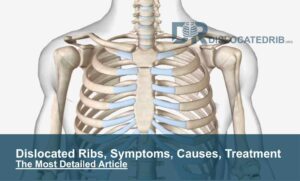Delving into Rib Fixation: Exploring Its Causes, Symptoms, and Treatment
Rib fixation, a condition where a rib becomes stuck in a certain position and prevents proper movement, can disrupt the delicate balance of the rib cage and lead to a range of discomfort and limitations. Understanding the causes, possible symptoms, and treatment options for rib fixation is crucial for effective management and relief.

Causes of Rib Fixation
Several factors contribute to the development of rib fixation:
Trauma
Direct blows to the chest, such as falls or car accidents, can cause damage to the cartilage or ligaments that connect the ribs, leading to fixation. This is because these connective tissues provide stability and support to the rib cage, and when they are damaged, the ribs can become misaligned or stuck in a fixed position.
Postural Imbalances
Poor posture, for example, slouching or hunching, can put excessive strain on the ribs, particularly the upper ribs. This is because when we slouch, we shift the weight of our upper body forward, which can cause the ribs to become compressed and stuck in a fixed position. Over time, this can lead to rib fixation and other musculoskeletal problems.
Muscle Imbalances
Weak or tight muscle tissues in the upper back, chest, and shoulders can also contribute to rib fixation. Tight muscles can pull the ribs out of alignment, while weak muscles fail to provide adequate support, allowing the ribs to become fixed. For example, tight chest muscle ligaments can pull the ribs inward, while weak back muscles can allow the ribs to jut outward.
Other Underlying Medical Conditions That May Lead to Rib Fixation
Underlying medical conditions, such as osteoporosis, arthritis, or fibromyalgia, can sometimes cause rib fixation. These conditions can weaken the bones and cartilage in the rib cage, making them more susceptible to damage and fixation.
Other Factors
In addition to all the factors mentioned above, other factors that may contribute to rib fixation include:
- Repetitive movements: Activities that involve repetitive overhead movements, such as weightlifting or sports, can put strain on the ribs and their supporting muscles, increasing the risk of fatigue and fixation.
- Repetitive coughing or sneezing: Sudden, forceful movements, such as coughing or sneezing, can also stress the ribs and their supporting structures, increasing the risk of fixation.
- Sleep positions: Regularly sleeping in certain positions, such as on the stomach or side, can put pressure on the ribs and contribute to fixation.
Symptoms of Rib Fixation
The symptoms of rib fixation can range from mild to severe and may also vary, and this depends on the location of the fixated rib:
- Sharp or stabbing pain in the ribs or chest
- Difficulty breathing due to restricted rib movement
- Numbness or tingling in the arms or hands caused by nerve compression
- Limited range of motion around the shoulders or arms
Diagnosing Rib Fixation
A thorough medical history and physical examination are typically used to diagnose rib fixation. The doctor will assess your symptoms, range of motion, and posture and may order imaging tests, such as X-rays or MRIs, to rule out other potential causes of pain.
Treating Rib Fixation
The treatment approach for rib fixation depends on the severity and cause of the fixation. In mild cases, conservative treatment options may be sufficient, including rest, pain medication, and physical therapy. Physical therapy can assist in stretching and strengthening the muscles surrounding the affected rib, promoting proper alignment and movement.
More invasive interventions may be considered for more severe cases or when conservative treatment fails. These may include manual manipulation by a physical therapist or chiropractor to gently release the fixated rib or, in rare cases, surgery to address underlying bone or cartilage damage.
Preventing Rib Fixation
By adopting various healthy habits, one can significantly reduce your risk of developing rib fixation:
- Warm up before any form of exercise, and remember to cool down afterward.
- Stretch regularly; this will improve flexibility and range of motion.
- Lift weights with proper form to avoid straining your muscles.
- Maintain good posture.
- Wear a supportive brace during activities that put you at risk for injury.
Benefits of Stretching Regularly
Stretching regularly offers a multitude of benefits, including:
- Improved flexibility: Stretching elongates muscle fibers and connective tissues, increasing your range of motion and making it easier to perform various everyday activities and participate in sports and exercises.
- Reduced muscle soreness: Good stretching can help reduce muscle soreness and stiffness, especially after exercise. This can improve your recovery time and overall physical performance.
- Enhanced circulation: Stretching improves blood flow to muscles, which can help to deliver oxygen and nutrients and remove waste products. This can promote muscle health and recovery.
- Reduced risk of injuries: Stretching can help improve flexibility and coordination, reducing your risk of injuries during exercise or activities.
- Improved posture: Stretching can help to enhance overall posture by lengthening tight or stiff muscles and strengthening weak muscles. This can lead to a more balanced and pain-free body.
Examples of Stretches to prevent rib fixation
Here are a few examples of effective stretches for different muscle groups:
- Hamstring stretch: Sit on the floor with one leg extended horizontally out in front of you. Bend forward at the hips, reaching towards your toes. Hold for 30 seconds, then repeat on the other side.
- Quadriceps stretch: Stand with one leg forward and the other leg back. Bend the front knee, keeping your back leg straight. Hold for 30 seconds, then repeat on the other side.
- Chest stretch: Interlace your fingers to form a lock behind your back, elbows bent. Gently pull your elbows back towards your spine. Hold for 30 seconds.
- Shoulder stretch: Raise your arms to the sides, palms facing down. Slowly bend forward at the elbows, bringing your hands towards each other. Hold for 30 seconds.
- Neck stretch: Gently and slowly tilt your head to one side, then bring your ear towards your shoulder. Hold for 10 seconds, then repeat on the other side.
Steps for rib fixation Stretching
Here are some general steps to follow when stretching:
- Warm-up: Before stretching, it’s essential to warm up your muscles to prevent injury. This can be done with light cardio exercises/workouts, such as walking or jogging in place, for 5-10 minutes.
- Hold each stretch for 30 seconds: Don’t bounce or jerk while stretching. Hold each stretch for 30 seconds, feeling a gentle pull in the muscle, but not pain.
- Breathe deeply: Breathe deeply and evenly throughout the stretching session. This will help to relax your muscles and improve your flexibility.
- Listen to your body: Don’t push yourself too hard. If you feel pain, stop the stretch immediately.
- Stretch regularly: Aim to stretch for 10-15 minutes 2-3 times weekly.
Additional Tips
Here are a few additional tips for stretching:
- Stretch different muscle groups: Don’t just focus on the same muscles every time you stretch. Stretch all major muscle groups, including hamstrings, quads, chest, shoulders, and neck.
- Use props: Use props like yoga blocks or straps to help you get deeper into your stretches.
- Vary your routine: Change your stretching routine every few weeks to keep your muscles challenged and engaged.
- Consult a doctor: If you have any underlying health conditions, consult your doctor before starting a stretching program.
conclusion
Rib fixation is a condition that can cause significant discomfort and limitations. Early diagnosis and treatment are important to prevent the condition from worsening and improve overall well-being. Following the tips outlined in this article can help reduce your risk of developing rib fixation and promote overall rib health. Remember, we recommend always going to your physician for professional advice when you have experienced any form of rib injury or dislocation.
Sources
- “Rib Fixation: What Is It and How Is It Treated?” Spine-health.com. Retrieved from https://www.ncbi.nlm.nih.gov/pmc/articles/PMC9678797/
- “Rib Fixation: A Guide to Symptoms, Causes, and Treatments” Healthline.com. Retrieved from https://my.clevelandclinic.org/health/diseases/17434-rib-fracture-broken-rib
- “Rib Fixation: Symptoms, Causes, and Treatment” Verywellhealth.com. Retrieved from https://www.absolutelifewellnesscenter.com/services/treatment-of-car-accident-injuries/
- “Rib Fixation: Symptoms, Causes, and Treatment” WebMD.com. Retrieved from https://www.uptodate.com/contents/surgical-management-of-severe-rib-fractures
- “Rib Fixation: What Is It and How to Treat It?” Mayo Clinic.org. Retrieved from https://www.mayoclinic.org/medical-professionals/trauma/news/6-year-old-undergoes-rib-stabilization-surgery/mac-20429284
- Tsao, J., & Patel, D. (2015). Rib fixation: A case series. The Journal of Manual & Manipulative Therapy, 23(6), 218-221.
- Krein, A. J., & Sobel, J. D. (1991). Rib fixation is treated by arthrocentesis and manipulation. Journal of Manipulative and Physiological Therapeutics, 14(3), 166-169.
- LeBlanc, I. K., & Miller, B. F. (1986). Treatment of rib fixation with manual therapy. Journal of the American Physical Therapy Association, 66(5), 618-624.



